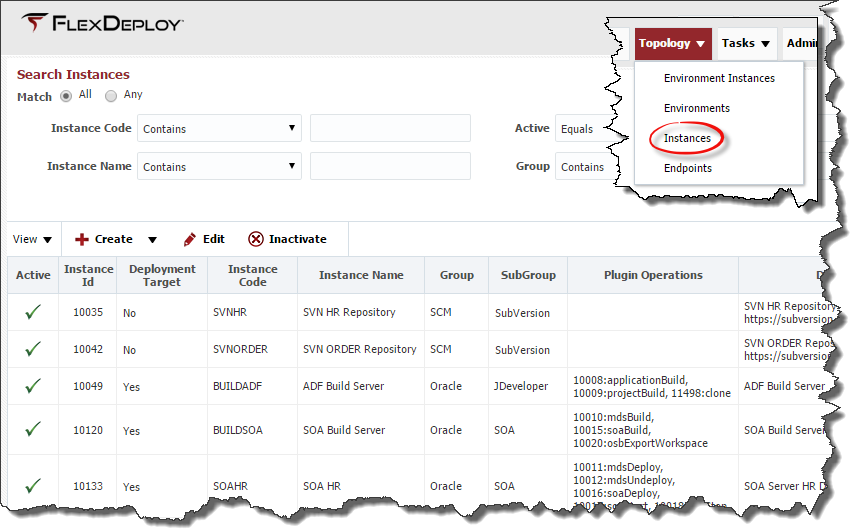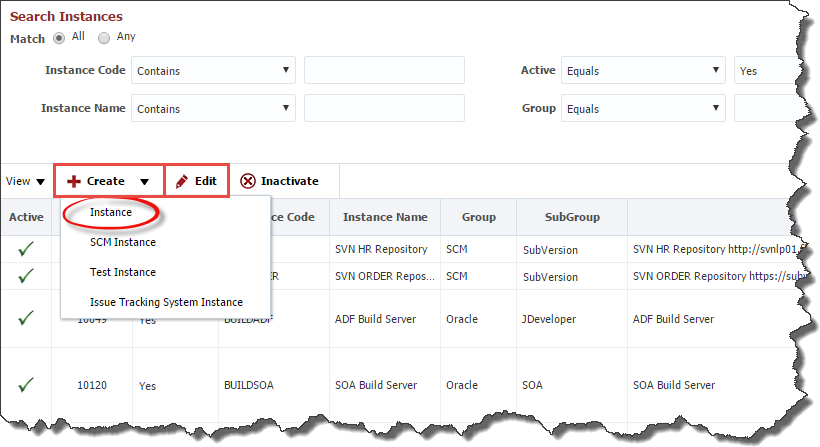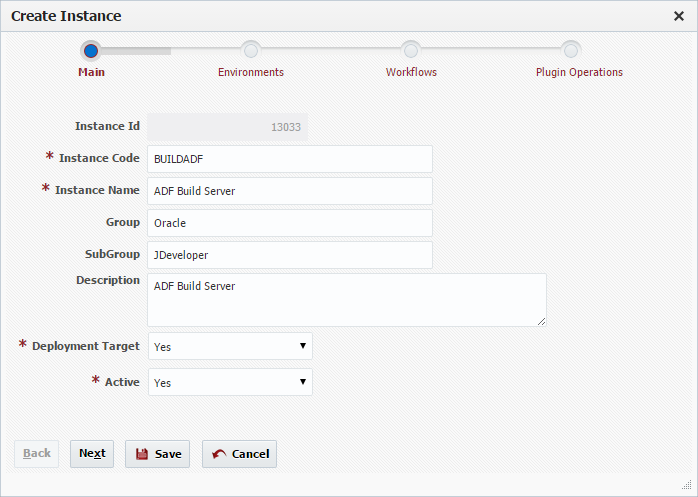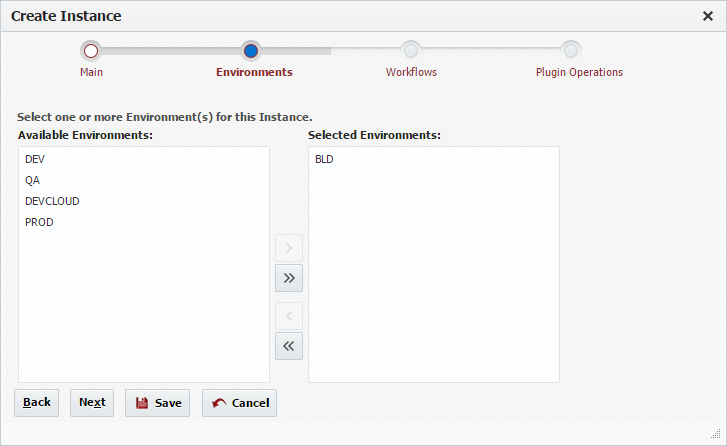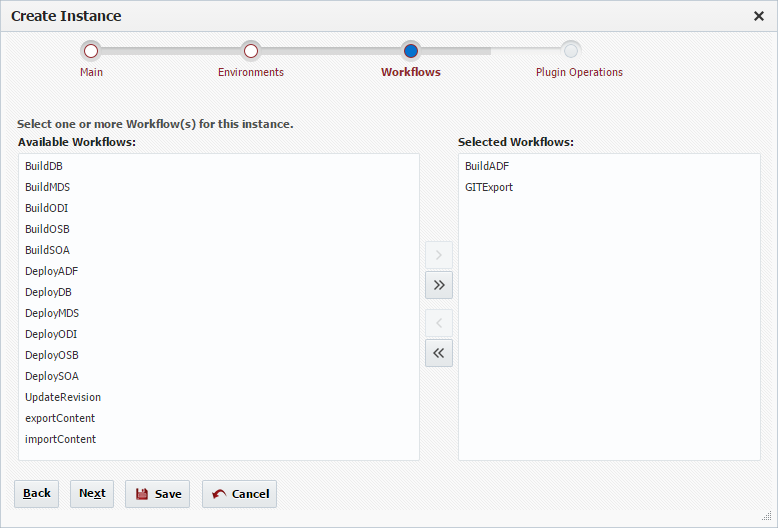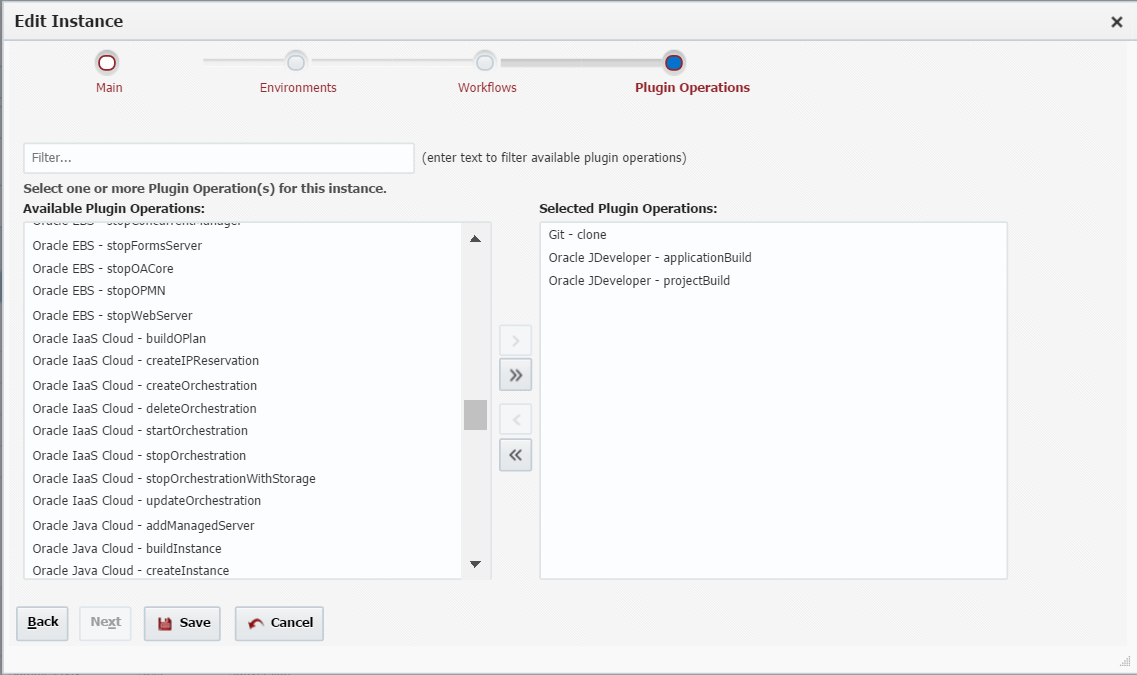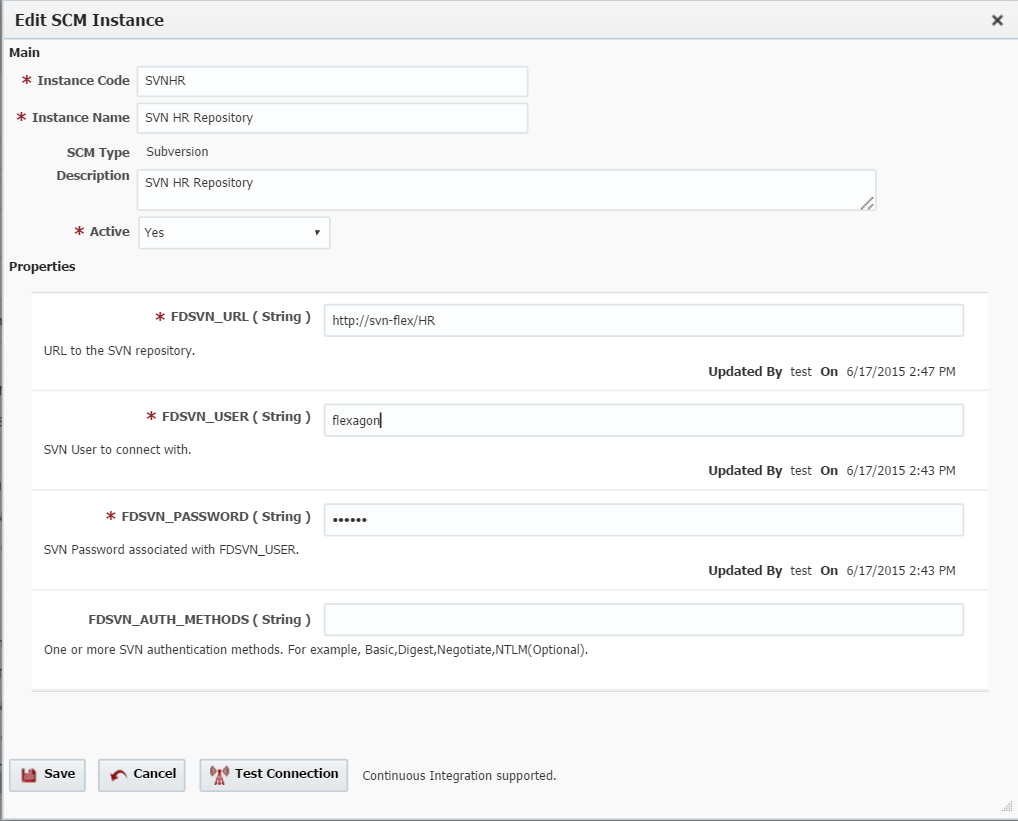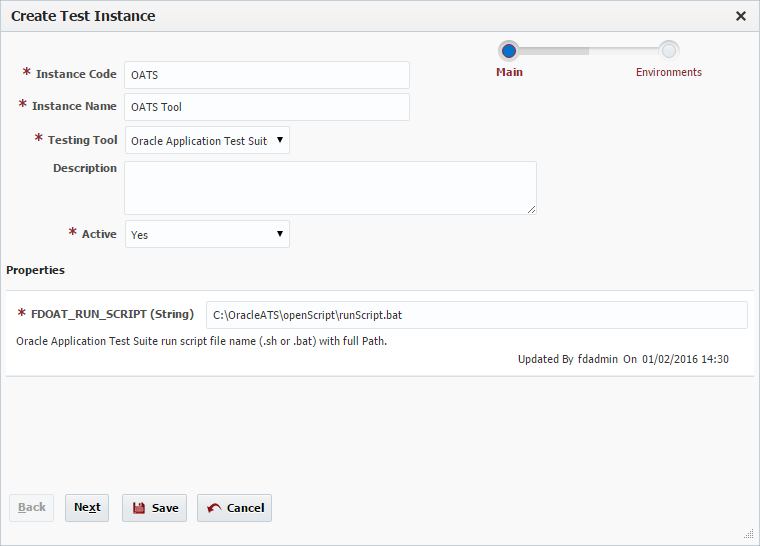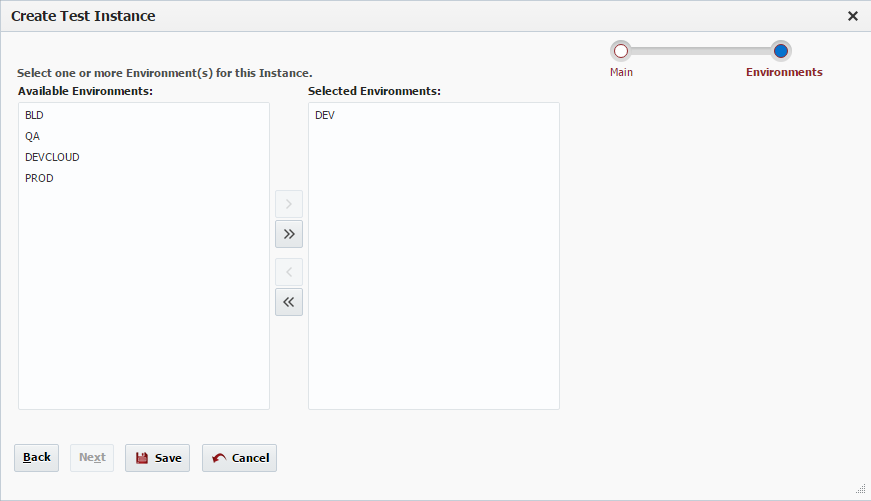- style
Instances
An Instance is a logical concept representing a technology running across its environment lifecycle. For example,
- You may have an Oracle SOA Suite instance (SOA1) for most composites, and a second instance (SOA2) for hosting composites which contain sensitive information such as financial or HR related data.In this case, you would create two Instances in FlexDeploy named SOA1 and SOA2. You can define Name and Code for instances as per what makes sense for your topology.
- You may have requirement to perform build for JDeveloper 11.1.1.9 and JDeveloper 12.2.1. In which case you can create JDEV11119 and JDEV1221 instances.
Example #1 Instances for ADF Build/Deploy
| Instance Code | Instance Name | Notes |
|---|---|---|
| ADF11119 | ADF 11.1.1.9 | ADF runtime 11.1.1.9 installation with WebLogic 10.3.6 |
| ADF1221 | ADF 12.2.1 | ADF runtime 12.2.1 installation with WebLogic 12.2.1 |
| JDEV11119 | JDeveloper 11.1.1.9 | JDeveloper 11.1.1.9 installation |
| JDEV1221 | JDeveloper 12.2.1 | JDeveloper 12.2.1 installation |
Example #2 Instances for ADF Build/Deploy
This is simple variation from Example #1 above, where Build and Deploy instances are named so that users can easily match Build with Deploy instance.
| Instance Code | Instance Name | Notes |
|---|---|---|
| ADF11119 | ADF 11.1.1.9 | ADF runtime 11.1.1.9 installation with WebLogic 10.3.6 |
| ADF1221 | ADF 12.2.1 | ADF runtime 12.2.1 installation with WebLogic 12.2.1 |
| ADFBUILD11119 | ADF Build 11.1.1.9 | JDeveloper 11.1.1.9 installation |
| ADFBUILD1221 | ADF Build 12.2.1 | JDeveloper 12.2.1 installation |
There are 4 types of instances:
- Target Instances (often referred to as just Instance) support managing both build and deploy.
- SCM (Source Code Management) Instances allow the user to manage a shares SCM instance like Subversion, Git, TFS, CVS etc.
- Test Instances allow the user to manage a separate test instance when the test tooling is not located on the deploy or build server. An example would be SOAPUI that is installed on its own server and is used to test deployment across many target instances.
- Issue Track System Instances allow the user to manage a separate ITS instance that is not located on the deploy or build server. An example would be Jira that is installed on its own server and is used to manage issues that are resolved.
Viewing Instances
To view the list of instances defined within FlexDeploy, select Topology -> Instances from the menu.
By default, all active instances are displayed in the search results. To refine the search results, select one or more criteria options and click on the Search button. Select the Any radio button to indicate the search results should include instances matching any of the specified criteria, or the All radio button to indicate that the search results should only include instances matching all of the specified criteria. Click on the Reset button to return to the default search criteria form.
Creating/Editing an Instance
Creating/Editing a Target Instance
To create a target Instance for either build or deploy click the Create button and select Instance. To edit an instance, select an existing instance and click the Edit button.
Enter values for the following fields.
Field Name | Required | Description |
|---|---|---|
Instance Id | N/A | System generated identifier (read-only). |
Instance Code | Yes | Short name for the instance. |
Instance Name | Yes | Long display name for the instance. |
Group | No | An optional group identifier which can be useful when searching for Instances. |
SubGroup | No | An optional subgroup identifier which can be useful when searching for Instances. |
Description | No | A description of the instance. |
Deployment Target | Yes | Whether the instance can be deployed to. Defaults to "Yes". |
Active | Yes | Whether or not the instance is active in the system. Defaults to "Yes". |
Click the Next button to associate Environments to this instance.
Shuttle environments from Available Environments to Selected Environments to associate them to this instance. To disassociate environments from the instance, shuttle the environments from Selected Environments back over to Available Environments. If you already associated the instance to one or more environments using the Environment Wizard you will notice that the association carries forward here, since it is bi-directional.
Click the Next button to associate workflows to this instance. By associating workflows to the instance, you are indicating that any user defined workflow properties need to be configured for this instance across all selected environments (for environment instance scoped properties) or all referencing projects (for project scoped properties). See Workflows chapter for details on creating workflow properties.
Shuttle workflows from Available Workflows to Selected Workflows to associate them to this instance. To disassociate workflows from the instance, shuttle the workflows from Selected Workflows back over to Available Workflows.
Click the Next button to associate plugin operations to this instance. By associating plugin operations to the instance, you are indicating that any environment instance scoped properties defined for those plugin operations need to be configured for the instance across all selected environments. Likewise, any projects which reference the instance must define any associated project-scoped properties. In order to find specific plugin operations, type in Filter... text box and available Plugin Operations will be filtered accordingly.
Shuttle plugin operations from Available Plugin Operations to Selected Plugin Operations to associate them to this instance. To disassociate plugin operations from the instance, shuttle the plugin operations from Selected Plugin Operations back over to Available Plugin Operations.
Click the Save button to save the changes to the instance and return to the list of FlexDeploy instances.
Creating/Editing an SCM Instance
To create an SCM instance, click the Create button and select SCM Instance. To edit an existing instance, select an instance and click the Edit button.
Enter values for the fields as described in figure below. Selection of the SCM type dynamically prompts for properties required to for that SCM. Clicking the Test Connection button will use the values you entered to connect to the SCM instance.
Click the Save button to save the changes.
Field Name | Required | Description |
|---|---|---|
Instance Code | Yes | Short name for the instance. |
Instance Name | Yes | Long display name for the instance. |
SCM Type | Yes | The SCM Type. Subversion, GIT, Microsoft TFS, CVS are the supported SCM Instance Types. Once SCM Instance is saved, this can not be modified. |
Description | Yes | A description of the instance. |
Active | Yes | Whether or not the instance is active in the system. Defaults to "Yes". |
URL | Depends | URL to the repository (SubVersion,Git, TFS or CVS) |
User | Depends | User name to login to the repository. |
Password | Depends | Password to login to the repository. |
Creating/Editing a Test Instance
To create a test instance, click the Create button and select Test Instance. To edit an existing instance, select an instance and click the Edit button.
Enter values for the fields as described in the table below.
Field Name | Required | Description |
|---|---|---|
Instance Code | Yes | Short name for the instance. |
Instance Name | Yes | Long display name for the instance. |
Testing Tool | No | The testing tool that will be run on this test instance. |
Description | Yes | A description of the instance. |
Active | Yes | Whether or not the instance is active in the system. Defaults to "Yes". |
If the selected testing tool has any properties defined, then you can set up values for those properties on the first screen of the wizard.
Click the Next button to associate Environments to this instance.
Shuttle environments from Available Environments to Selected Environments to associate them to this instance. To disassociate environments from the instance, shuttle the environments from Selected Environments back over to Available Environments. If you already associated the instance to one or more environments using the Environment Wizard you will notice that the association carries forward here, since it is bi-directional.
Click the Save button to save the changes.
Creating/Editing an Issue Tracking Instance
To create an Issue Tracking System instance, click the Create button and select Issue Tracking System Instance. To edit an existing instance, select an instance and click the Edit button.
Enter values for the fields as described in the table below.
Field Name | Required | Description |
|---|---|---|
Instance Code | Yes | Short name for the instance. |
Instance Name | Yes | Long display name for the instance. |
Issue Tracking System | No | The issue tracking system that will be used. |
Description | Yes | A description of the instance. |
Active | Yes | Whether or not the instance is active in the system. Defaults to "Yes". |
If the selected Instance Tracking System has any properties defined, then you can set up values for those properties on the first screen of the wizard.
Click the Save button to save the changes.
Inactivating/Activating Instances
To inactivate an Instance at any time, select an existing instance and click the Inactivate button. This will temporarily hide that instance until, a search is performed where the criteria for Active is switched to "No". To reactivate an instance, select the desired instance and click the Edit button. Then change the drop down menu for active to "Yes" and click Save. This instance is now active in the system again and ready for use.
- style
